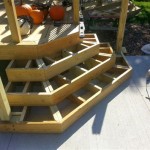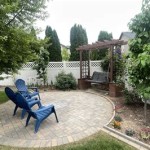Design and Construction of a Stone Patio Chimney
A stone patio chimney introduces a focal point and an element of warmth to outdoor living spaces. These durable and aesthetically pleasing structures require careful planning, design considerations, and precise construction techniques to ensure both functionality and long-term stability. The selection of appropriate materials, adherence to safety regulations, and a thorough understanding of structural principles are crucial for a successful project.
The allure of a stone patio chimney resides in its ability to seamlessly blend with natural landscapes while providing a comforting source of heat and light. It extends the usability of outdoor spaces into cooler seasons, allowing for gatherings and relaxation around a crackling fire. The enduring beauty of stone, coupled with the functionality of a chimney, makes it a worthwhile investment for homeowners seeking to enhance their outdoor living experiences.
Planning and Design Considerations
Before embarking on the construction of a stone patio chimney, meticulous planning is essential. This phase involves considering various factors, including the desired size and style, the chimney's location, local building codes and regulations, and the overall aesthetic integration with the existing patio and surrounding environment. A detailed design plan serves as a roadmap for the entire project, ensuring that all elements are properly accounted for and that the final product meets both functional and aesthetic requirements.
The size of the chimney should be proportional to the size of the patio and the intended use. A chimney that is too small may not provide sufficient draft, leading to smoke issues, while a chimney that is too large may overwhelm the space. The style of the chimney should complement the existing architectural style of the house and the overall design of the patio. Options range from rustic, natural stone designs to more modern, sleek creations. Careful consideration should be given to the type of stone used, as it will significantly impact the overall appearance and durability of the chimney.
Location is another critical factor. The chimney should be positioned in a location that minimizes obstructions to views and maximizes airflow. It is crucial to maintain adequate clearance from combustible materials, such as trees, fences, and the house itself. Local building codes typically specify minimum clearance requirements to prevent fire hazards. Additionally, the prevailing wind direction should be considered to minimize the potential for smoke to blow back into the patio area.
Compliance with local building codes and regulations is paramount. This includes obtaining the necessary permits before commencing construction. Building codes often dictate specific requirements for chimney height, firebox dimensions, flue size, and the use of approved materials. Failure to comply with these regulations can result in costly rework and potential safety hazards. Consulting with a qualified building inspector or contractor is highly recommended to ensure compliance.
The design plan should include detailed drawings or sketches of the chimney, including dimensions, material specifications, and construction details. These drawings will serve as a guide for the construction process and will help to ensure that the final product matches the intended design. The plan should also incorporate considerations for accessibility for cleaning and maintenance.
Choosing the right type of stone is crucial for both the aesthetic appeal and the structural integrity of the chimney. Natural stones such as fieldstone, limestone, sandstone, and granite are commonly used for chimney construction. Each type of stone has its own unique characteristics in terms of color, texture, and durability. The selected stone should be resistant to weathering, temperature fluctuations, and chemical exposure. It is also important to ensure that the stone is compatible with the mortar used for construction.
The foundation is the load-bearing base of the chimney and must be designed to support the weight of the entire structure. The foundation should be constructed on stable, compacted soil or concrete. The depth and dimensions of the foundation will depend on the size and weight of the chimney, as well as the soil conditions. A reinforced concrete footing is typically used to provide a solid base for the chimney. The foundation should extend below the frost line to prevent heaving and cracking caused by freezing and thawing cycles.
Construction Techniques and Materials
The construction of a stone patio chimney requires a combination of masonry skills, attention to detail, and adherence to safety protocols. Proper techniques and materials are essential for creating a durable, safe, and aesthetically pleasing structure. A well-constructed chimney will not only provide a reliable source of heat but will also enhance the overall appearance of the outdoor living space.
The firebox is the heart of the chimney and is where the fire is built. It must be constructed of fire-resistant materials, such as firebrick, to withstand the intense heat. The firebox should be sized appropriately for the intended use, with adequate depth and width to accommodate the fire. The firebox should also be designed with proper ventilation to ensure efficient combustion and minimize smoke production. A damper should be installed to control the airflow and prevent drafts when the chimney is not in use.
The flue is the channel through which the smoke and gases escape from the firebox to the outside air. The flue must be properly sized and lined to ensure efficient draft and prevent the buildup of creosote. Options for flue lining include clay tiles, stainless steel liners, and cast-in-place concrete liners. The flue liner should be installed according to the manufacturer's instructions and should be inspected regularly for cracks or damage.
The chimney cap is a protective covering that prevents rain, snow, and debris from entering the flue. A chimney cap also helps to prevent downdrafts, which can cause smoke to back up into the patio area. Chimney caps are available in a variety of materials, including stainless steel, copper, and galvanized steel. The chimney cap should be properly sized for the flue and should be securely attached to the chimney.
Mortar is the bonding agent that holds the stones together. The selection of the appropriate mortar is crucial for the durability and longevity of the chimney. Types N and S mortar are often recommended for chimney construction, as they provide good strength and flexibility. The mortar should be mixed according to the manufacturer's instructions and should be applied evenly between the stones. Proper curing of the mortar is essential for achieving maximum strength and durability.
The process of laying the stone is an art form that requires skill and experience. The stones should be carefully selected and placed to create a visually appealing pattern. The stones should be staggered to create a strong, interlocking structure. The mortar joints should be properly tooled to create a weatherproof seal and to enhance the appearance of the chimney. Regular cleaning of excess mortar is essential to maintain a clean and professional finish.
Proper drainage is essential to prevent water damage to the chimney and surrounding patio area. The foundation should be sloped away from the chimney to allow water to drain away. Weep holes should be incorporated into the chimney design to allow water to escape from the interior of the structure. A waterproof sealant should be applied to the exterior of the chimney to prevent water penetration.
Adherence to safety protocols is paramount throughout the construction process. This includes wearing appropriate personal protective equipment, such as gloves, safety glasses, and a dust mask. Ensure that scaffolding and ladders are properly secured and that all tools are in good working condition. Work should be paused during inclement weather conditions, such as high winds or heavy rain. Consult with a qualified professional if unsure about any aspect of the construction process.
Ensuring Safety and Longevity
Once the stone patio chimney is constructed, ongoing maintenance and safety precautions are crucial for ensuring its long-term performance and the safety of its users. Regular inspections, proper cleaning, and adherence to safe burning practices are essential for preventing potential hazards and extending the lifespan of the chimney.
Regular inspections should be conducted at least once a year, preferably in the fall before the heating season begins. The inspection should include a thorough examination of the chimney structure, including the firebox, flue, and chimney cap. Look for signs of cracks, spalling, or deterioration of the stone or mortar. Check for any obstructions in the flue, such as bird nests or debris. Examine the chimney cap for damage or corrosion.
Cleaning the chimney regularly is essential for removing creosote buildup. Creosote is a highly flammable substance that accumulates in the flue as a result of burning wood. Excessive creosote buildup can lead to chimney fires, which can be extremely dangerous. The frequency of cleaning will depend on the type of wood burned and the frequency of use. Professional chimney sweeps are equipped with the tools and expertise to safely and effectively remove creosote buildup.
Proper burning practices can help to minimize creosote buildup and ensure efficient combustion. Only burn seasoned wood that has been dried for at least six months. Seasoned wood burns cleaner and produces less smoke than green wood. Avoid burning treated wood, painted wood, or other materials that can release harmful toxins into the air. Start with a small fire and gradually increase the size as needed. Provide adequate airflow to the fire by opening the damper fully and ensuring that the firebox is well-ventilated.
Be aware of the signs of a chimney fire. These include a loud roaring sound, a dense column of smoke, and sparks or flames shooting out of the chimney. If there is suspicion of a chimney fire, immediately call the fire department and evacuate the premises. Do not attempt to extinguish the fire yourself, as this can be extremely dangerous. Once the fire is extinguished, have the chimney inspected by a qualified professional to assess the damage and determine the necessary repairs.
Consider installing a carbon monoxide detector near the patio area. Carbon monoxide is a colorless, odorless gas that can be produced by incomplete combustion. Exposure to carbon monoxide can be deadly. A carbon monoxide detector will provide an early warning of the presence of this dangerous gas.
Repair any damage to the chimney promptly. Cracks in the stone or mortar should be repaired to prevent water penetration and further deterioration. Replace any damaged or corroded chimney components, such as the chimney cap or flue liner. Addressing minor issues promptly can prevent them from escalating into more serious problems.
Maintaining the surrounding patio area is also important. Keep the area around the chimney clear of combustible materials, such as leaves, branches, and furniture. Trim any overhanging trees or shrubs that could pose a fire hazard. Ensure that the patio surface is level and stable to prevent tripping hazards.
By following these safety and maintenance guidelines, homeowners can ensure that their stone patio chimney provides years of enjoyment and safe, reliable heat. A well-maintained chimney will add value to the property and enhance the overall outdoor living experience.

The Outdoor Patio Fireplace Homeside To Poolside Stones

Should I Install A Patio Fire Pit Or Fireplace In My Backyard

Outdoor Stone Fireplace Landscaping Network

Outdoor Patio Fireplace Kitchen Furniture Stonewood S

How To Build An Outdoor Fireplace Step By Guide Buildwithroman

How To Build An Outdoor Stacked Stone Fireplace

Outdoor Stone Paver Firepits Fireplaces Installer Minneapolis St Paul

30 Outdoor Fireplace Ideas Cozy Fireplaces

Stonetutorials Living Stone Masonry

Outdoor Fireplaces From System Pavers
Related Posts








